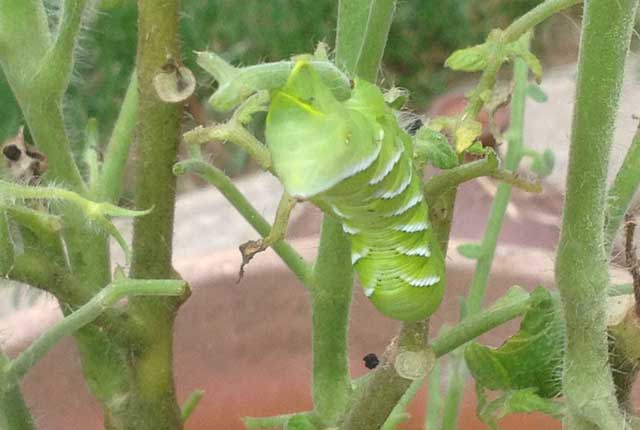Sphinginae subfamily
Sphingini tribe:
 |
Agrius cingulata,
BAMONA Pink-spotted Hawkmoth: Plants in Convolvulaceae family: Ipomoea batatas (sweet potato); and Solanaceae family,
especially (Datura) (jimsonweed); related plants. Also brown form. Very large, dark spiracular circles. |
 |
Ceratomia amyntor WO, Elm Sphinx; Four-horned Sphinx:
Elm (Ulmus), birch (Betula), basswood
(Tilia), cherry (Prunus).
Both green, brown forms. Four thoracic "horns".
|
 |
Ceratomia catalpae WO, Catalpa Sphinx:
Catalpa species: (Catalpa bignoniodes; C. speciosa) in
Bignoniaceae family.
Larvae are mostly white in early instars.
|
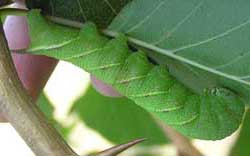 |
Ceratomia hageni WO, Hagen's Sphinx , Osage Orange Sphinx:
Osage orange (Maclura pomifera); granulous appearance with variable amounts of purple
along oblique white stripes.
|
 |
Ceratomia undulosa WO, Waved Sphinx: Fraxinus, Ligustrum, Quercus, Crataegus,
Chionanthus virginicus. Fifth instar: spiracular ovals decidedly red, anal horn off-white to pinkish laterally.
|
 |
Dolba hyloeus WO, Pawpaw Sphinx:
Pawpaw (Asimina triloba), littleleaf sweetfern (Myrica aspleniifolia), possum haw (Ilex decidua),
inkberry (Ilex glabra), Tall Gallberry Holly (Ilex coriacea). Probably feed on Ilex verticellata in Quebec.
|
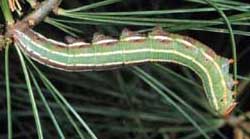 |
Lapara coniferarum WO, Southern Pine Sphinx:
Various pine species, including loblolly pine (Pinus taeda),d longleaf pine (P. pinaster). Well camouflaged and are without an anal horn.
|
 |
Lintneria eremitus WO, Hermit Sphinx.
Beebalm (Monarda fistulosa), mints (Mentha), bugleweed (Lycopis), sage (Salvia). Collinsonia canadensis (Canada Horsebalm,
Richweed, Hardhack, Heal-All, Horseweed), houseplant, Coleus.
|
 |
Manduca quinquemaculatus WO, Five-spotted Hawkmoth:
Tomato Hornworms: black horn at end of abdomen. Potato, tobacco, tomato, other plants in nightshade family (Solanaceae).
|
 |
Manduca rustica WO, Rustic Sphinx:
Numerous white nodules on thorax, seven pairs of oblique, blue-gray stripes along body.
Horn: white at base, blue-gray tip.
|
 |
Manduca sexta M/BvW, Carolina Sphinx:
Tobacco Hornworms, red-tipped horn. Tobacco, tomato, occasionally potato, pepper crops, plants in nightshade family (Solanaceae).
|
Manduca sexta larva, tomato foliage, Portland, September 8, 2013, Melodie and Bretti van Wye.
 |
Paratrea plebeja WO, Plebeian Sphinx:
Common trumpetcreeper (Campsis radicans), Florida yellow-trumpet (Tecoma stans), lilac (Syringa species),
passionflower (Passiflora species).Horn blue, preceded by yellow dash.
|
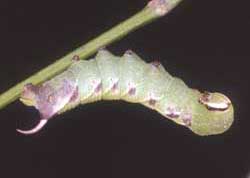 |
Sphinx canadensis WO, Sphinx canadensis, Canadian Sphinx:
Uncommon, but it should be present. White ash (Fraxinus americana) and blueberry
(Vaccinium).
|
 |
Sphinx chersis WO, Northern Ash Sphinx, Great Ash
Sphinx: Pale bluish green. Head has pair of yellow lateral bands meeting at apex. Oblique, pale, lateral stripes,
bordered anteriorly with darker green. Ash, lilac, privet, cherry, and quaking aspen.
|
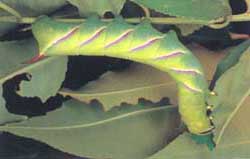 |
Sphinx drupiferarum WO, Wild Cherry Sphinx:
Hide by day, Feed on cherry, plum, apple at night.
Amelanchier nantuckensis in Massachusetts; Michigan on Prunus serotina.
|
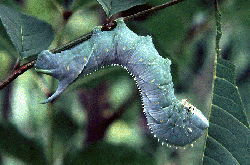 |
Sphinx franckii WO, Franck's Sphinx Moth:
Various species of ash (Fraxinus). Raised, pointed bumps, especially near head and thorax give this
caterpillar reptilian appearance.
|
 |
Sphinx gordius WO, Apple Sphinx:
Apple (Malus), sweetfern (Myrica), Carolina rose (Rosa carolina), blueberry, huckleberry (Vaccinium), white spruce
(Picea glauca), American larch (Larix laricina), alder (Alnus).
|
 |
Sphinx kalmiae WO, Laurel Sphinx:
Laurel Sphinx larvae feed primarily on lilac and fringe. Larvae have also been found on privet.
|
Smerinthini Tribe:
 |
Amorpha juglandis WO, Walnut Sphinx:
Walnut, butternut (Juglans), hickory (Carya), alder (Alnus), beech (Fagus),
hazelnut (Corylus), hop-hornbeam (Ostrya).
|
 |
Pachysphinx modesta WO, Modest Sphinx or Poplar Sphinx:
Larvae feed on poplars and cottonwood. Anal horn all but disappears in final instar.
|
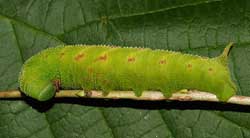 |
Paonias astylus
Huckleberry Sphinx: More common in southern Massachusetts and is a relatively uncommon species.
Only rarely are they seen in Maine. I never saw one in New Jersey.
|
 |
Paonias excaecata WO, Blinded Sphinx:
Larvae accept willows, birches, and cherries. I have also found them in the wild on oak in eastern Canada.
|
 |
Paonias myops WO, Small-eyed Sphinx:
The larvae depicted is probably third instar. There may be more red spotting on the sides as larvae mature.
|
 |
Smerinthus jamaicensis
WO, Twin-spotted Sphinx: Birches, cherries, poplars, willows. Red markings on sides
vary greatly from specimen to specimen.
|
Macroglossinae subfamily
Dilophonotini tribe:
See Hemaris comparison to help distinguish
the next two species.
 |
Hemaris thysbe WO, Hummingbird Clearwing:
Also orangey-pink prepupal form. Lateral line runs from S1 to blue horn.
Viburnum; related plants.
|
 |
Hemaris diffinis WO, Snowberry Clearwing:
Snowberry (Symphoricarpos), honeysuckle (Lonicera), Coralberry, viburnums, Blue Dogbane
(Apocynum), dwarf bush honeysuckle (Diervilla lonicera).Horn: black, yellow base.
|
Philampelini tribe:
 |
Eumorpha achemon WO, Achemon Sphinx:
Grape (Vitis), Virginia Creeper (Parthenocissus quinquefolia), other vines, ivies (Ampelopsis).
Both light (green) form and darker (tan/brown) form. Note six "segmented" oblique lines.
|
 |
Eumorpha pandorus WO, Pandorus Sphinx: If you have Grape or Virginia Creeper nearby, then you might
encounter this species. Note five large white ovals. Orangey-brown and green forms also.
|
Macroglossini tribe:
 |
Amphion floridensis WO, Nessus Sphinix:
Virginia creeper, Grape (Vitis), ampelopsis (Ampelopsis), cayenne pepper (Capsicum). Larvae are green until the final instar.
|
 |
Darapsa choerilus WO, Azalea Sphinx:
Azalea, Viburnum; progress very rapidly. Larva, left, on Viburnum cassinoides: getting ready to
pupate. Color change from green to light burgundy-brown indicates pupation is imminent.
|
 |
Darapsa myron BAMONA, Virginia Creeper Sphinx, Grapevine Sphinx:
If you have foodplants indicated in common names, you probably myron. Hws: orange. Virginia creeper (Parthenocissus quinquefolia),
Grape (Vitis), Ampelopsis, Viburnum.
|
 |
Darapsa versicolor WO, Hydrangea Sphinx:
Larvae turn deep chocolate brown just prior to pupation,
"horn" on tail also turns downward as pupation draws near.
Smooth hydrangea (Hydrangea arborescens), buttonbush (Cephalanthus occidentalis), waterwillow (Decodon verticillatus).
|
 |
Deidamia inscriptum WO, Lettered Sphinx:
Grape (Vitis), ampelopsis (Ampelopsis), and Virginia creeper (Parthenocissus) all serve as larval hosts.
The alternating yellow and greyish-green rings across the back distinguish this larva.
|
 |
Hyles lineata WO, White-lined Sphinx:
Highly varied. Willow weed (Epilobium), four o'clock (Mirabilis), apple (Malus), evening primrose (Oenothera), elm
(Ulmus), grape (Vitis), tomato (Lycopersicon), purslane (Portulaca), Fuschia.
Red/black swellings split by dorso-lateral lines. |
 |
Sphecodina abbottii WO, Abbott's Sphinx:
Larvae feed at night on grape (Vitis), ampelopsis (Ampelopsis); hide on bark by day. Virginia creeper would also be a suitable host. Dark form
without the green patches. Note "raised eye", replacing anal horn.
|
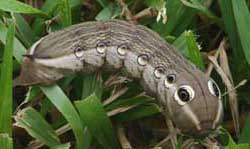 |
Xylophanes tersa WO, Tersa Sphinx:
Borreria, Catalpa, Manettia spp., Smooth buttonplant (Spermacoce glabra), starclusters (Pentas species), Joe-pie weed,
Hamelia patens, on Hedoydis nigricans. Green form may be more common.
|
|
|
